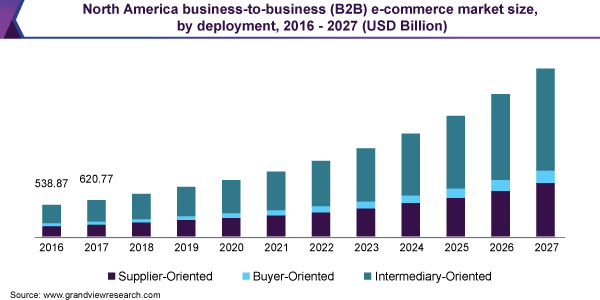What’s the biggest challenge of growing a B2B business? Of course, you need to outline a rock-solid sales process to acquire and retain customers. Also, you have to build a cross-platform B2B commerce strategy to reach prospective buyers at the right time. You even have to provide them with relevant and engaging content at each stage of the buyer’s journey.
But if you’re running a B2B business in 2021, your foremost priority should be to propel the transition to e-commerce. Reaching out to potential buyers on Facebook, LinkedIn, and other platforms isn’t enough. Your business also needs an awesome-looking website where people can browse and purchase your products.
B2B Commerce: Understanding the Challenges
Switching to B2B commerce comes with a diverse array of roadblocks. B2B business owners often perceive e-commerce as a cold selling technique. Considering that customer relationships play a key role in B2B conversions, many companies hesitate to dive into B2B commerce.
Also, there’s the notion that B2B buyers would be too skeptical about purchasing online. It’s understandable considering the larger order value and complexity of B2B transactions. Thus, a new buyer may find it difficult to trust your business without in-person interaction with sales reps. Also, transitioning to e-commerce could affect your brand’s credibility and reputation.
The B2B e-commerce market is a rapidly growing portion of the industry with a value of $5.7 trillion in 2019. It’s projected to grow at a remarkable CAGR of 17.5% between 2020 and 2027.
Here’s a glimpse of how the B2B e-commerce market is expected to grow in North America:

So, adopting B2B commerce is no longer an option for new-age B2B business: it’s becoming the norm. It isn’t surprising that more B2B companies are looking for ways to revamp their websites to accommodate the growing demand for e-commerce.
But how do you get started with the digital transformation of your B2B business? We’ll delve deeper into this topic in the following sections. But let’s first understand why there’s been a surge in the adoption of B2B commerce.
You Can’t Ignore B2B Commerce in 2021: Here’s Why
The COVID-19 pandemic has compelled businesses across all sectors and locations to escalate their digital transformation. With the normalization of home quarantine, lockdowns, and self-isolation, today’s consumers are open to making a broad spectrum of online purchases. From groceries and medicines to office supplies and furniture—consumers are willing to buy everything online.
The omnipresence of online shopping has driven B2B businesses to find new ways to reach their target audience. Whether you’re a manufacturer, distributor, or supplier, your potential buyers are ready to make complex business decisions via the Internet. This means if you don’t offer the right B2B e-commerce experience, you’ll likely lose your buyers to your competitors.
Also, switching to online operations can boost B2B sales reps' productivity and efficiency. Your reps no longer have to spend time commuting to clients’ offices for sales pitches. Instead, they can direct potential buyers to your website and persuade them to make a purchase.
Or they can use the website as a selling tool to nurture and convert leads. This empowers reps with more time and resources to focus on optimizing the sales process. Also, they can collaborate with other departments, including marketing and customer service, to deliver an outstanding customer experience.
It’s also worth mentioning that adopting B2B commerce is essential because of the shifting buyer preferences. First, 41% of B2B buyers agree that they want self-service functionality while purchasing products or providing services for their company. This highlights the need for building a user-friendly, accessible, and easily navigable B2B online store.
Additionally, it’s essential to understand that a majority of today’s B2B buyers are millennials. According to the research, 44% of millennial B2B buyers are key decision-makers in their companies. While 42% of them are employed in managerial positions, 35% of them hold director-level positions.

Needless to say, millennial buyers are more tech-savvy and self-sufficient than baby boomers or Gen X. This means they’re likely to conduct thorough research on their own and shortlist several options before contacting a sales rep. Or they might avoid engaging with a salesperson until they’re almost ready to purchase.
Catering to such self-dependent and tech-forward buyers requires you to transition to B2B commerce. It’s the only way you can keep up with the growing demands of modern buyers. Additionally, as businesses realize the benefits of e-commerce, they’re likely to continue their digital transformation even in a post-pandemic era.
So, how can you turn your B2B business into a thriving e-commerce venture? Let’s find out.
Kickstarting Your B2B Commerce Transformation
B2B e-commerce isn’t as simple as building an online store using an e-commerce platform or WordPress plugin. You still need your sales and customer support reps to acquire, engage, convert leads. The key is to strike a balance between digital and human touch points throughout the sales process.
Here are a few things you should keep in mind when getting started with B2B commerce:
1. Understand Your Buyer’s Journey
Whether you’re selling online or offline, you must have a deep understanding of your target buyers’ preferences and pain points. Ensure you identify their queries, problems, and needs at every stage of the buyer’s journey. Also, it’s essential to have a clear idea of the communication channels they’re likely to use to research before making a purchase.
This is crucial in B2B commerce because a buyer will have multiple touch points with your brand before reaching your website. For instance, they could come across one of the articles you’ve published as a guest author on a popular blog. Or they might be following you on social media for a while before they decide to check your website.
Make sure you identify and optimize each route a buyer could take to land on your website. You must understand your buyers’ mindset at each of these touchpoints to provide them with relevant and personalized content. Also, it’s a good idea to categorize buyers into individual segments based on their needs.
2. Make Self-Service a Priority
Provide buyers with all the tools and resources they need to make purchase decisions on their own. Whether they want to request a quote or place an order, a buyer should be able to accomplish each task on your website. Eliminate the need to contact salespeople at every step.
Create useful and valuable content for each stage of the buyer’s journey. For instance, buyers in the consideration stage could utilize product comparison guides and case studies while weighing various options. Likewise, buyers in the decision stage need more compelling content in the form of customer success stories and product demos.
Making this content readily available and accessible on your website is the key to flourishing in B2B commerce. Once you convert a buyer, continue to provide them with insightful content to help them utilize your products/services to the fullest. Apart from your website, explore other channels, such as social media and email, to connect with potential and existing buyers.
Additionally, you should simplify the checkout process to eliminate cart abandonment issues. You could even provide more user-friendly features, such as letting buyers place repeat orders in a few clicks. Or letting them use a previous order as a template to place a new order.
3. Optimize Your Website’s Search Functionality
A key step in creating a self-service user experience is to let buyers find the relevant products on your website. But including a search bar on your home page isn’t enough. You must ensure that the search functionality is equipped with cutting-edge technology to mimic the experience of using a search engine.
The Search function should preempt and interpret users’ queries. Advanced technologies, like natural language processing (NLP) and machine learning (ML), allow the feature to accurately interpret the customer's goal. The idea is to give buyers the option to find the right product by mentioning its color, shape, size, and other parameters.
Instead of browsing through various category and product pages, they can quickly find the right product to fit their needs. However, make sure you still provide them with the flexibility to enter product IDs or SKUs to find relevant products.
The advantage of enhancing the search functionality is that you’ll get access to a wealth of data about buyers. You can use website analytics tools to understand what they’re searching for and how you can further improve the user experience.
4. Take Advantage of Customer Data
B2B companies are now operating in a crowded space. As such, it is becoming increasingly difficult to fully understand customers and leads without proper data. B2B e-commerce makes it easy to collect data and analytics to bring new elements of value to clients. In some cases, these insights may also bring new revenue channels.
For instance, determining which products generate the most lead traffic allows B2B companies to highlight these items on their websites. Similarly, knowing which content generates the most bounce rates provides a clear picture of why the specific resource is not helpful to customers. Within the context of B2B commerce, this information is a valuable advantage over the competition. Each decision is data-driven which provides a greater chance of success.
Final Thoughts
The demand for B2B commerce has been escalating for a while now. However, the rate of adoption has skyrocketed owing to the impact of the pandemic. Offering advanced search and self-service functionalities on your website is the key to delivering a hassle-free customer experience. Also, make sure you handhold buyers with tailored content throughout the sales process.
Do you want to know more about making the transition to B2B commerce? Check out this insightful interaction between Teresa Zobrist (Zobrist Inc.) and Peter Wharton (HCL Commerce).




